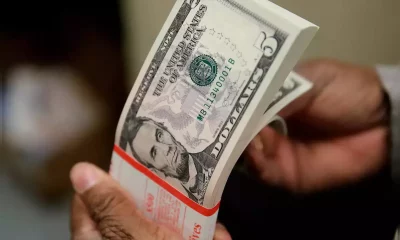Forex
Dollar rebound from sharp losses; Fed meeting in focus

The U.S. dollar edged higher in early European trade Friday, rebounding after the previous session’s sharp losses as traders sought out a safe haven after weak Chinese inflation data.
At 02:55 ET (06:55 GMT), the Dollar Index, which tracks the greenback against a basket of six other currencies, traded 0.1% higher at 103.358, having lost more than 0.7% in the previous session, its largest daily decline in weeks.
Safe haven dollar receives boost from Chinese data
The dollar was in demand early Friday after data showed that Chinese consumer inflation shrank in May from the prior month, while producer inflation fell at its sharpest pace in seven years.
This followed a string of weak economic readings from China in the past two weeks, which suggested that the second largest economy in the world, and a major regional growth driver, was struggling to rebound from its COVID hit.
This could push the Chinese government to roll out more supportive measures in the coming months, but this would likely weaken the yuan further, to the benefit of the dollar.
USD/CNY rose 0.1% to 7.1215, with the yuan hovering around six-month lows.
Dollar still on course for worst week since March
However, this bounce in the U.S. currency came after hefty losses in the previous session after weak employment data pointed to a pause in the Federal Reserve’s year-long rate-hiking cycle.
The greenback is down 0.6% for the week, set for its worst week since mid-March.
Data released on Thursday showed that the number of Americans filing new claims for unemployment benefits surged to the highest in more than 1½ years last week.
With signs of the labor market weakening, Tuesday’s release of the latest consumer prices index, for May, looms large as it comes out just before the central bank officials get together to make their decision on interest rates.
ECB’s de Guindos set to speak
EUR/USD fell 0.1% to 1.0777, with ECB Vice President Luis de Guindos due to speak at an event in Madrid later in the session.
Traders will be seeking guidance ahead of the European Central Bank’s policy-setting meeting next week, although the central bank is widely expected to hike once more.
Italian industrial production data for April is also due later in the session and is expected to climb just 0.1% on the month, an annual fall of 4.1%.
Elsewhere, GBP/USD edged higher to 1.2562, near a one-month high, AUD/USD traded flat at 0.6717, while USD/JPY rose 0.4% to 139.41.
USD/TRY rose 1.7% to 23.4950, with the lira falling to another record low against the greenback after President Tayyip Erdoğan appointed Hafize Gaye Erkan, a finance executive in the United States, to head Turkey’s central bank.
These moves suggest a turn towards orthodoxy in Turkish monetary policy, which could see the country’s economy hit with higher interest rates.

 Forex3 years ago
Forex3 years agoForex Today: the dollar is gaining strength amid gloomy sentiment at the start of the Fed’s week

 Forex3 years ago
Forex3 years agoUnbiased review of Pocket Option broker

 Forex3 years ago
Forex3 years agoDollar to pound sterling exchange rate today: Pound plummeted to its lowest since 1985

 Forex3 years ago
Forex3 years agoHow is the Australian dollar doing today?

 Cryptocurrency3 years ago
Cryptocurrency3 years agoWhat happened in the crypto market – current events today

 World3 years ago
World3 years agoWhy are modern video games an art form?

 Commodities3 years ago
Commodities3 years agoCopper continues to fall in price on expectations of lower demand in China

 Economy3 years ago
Economy3 years agoCrude oil tankers double in price due to EU anti-Russian sanctions

































